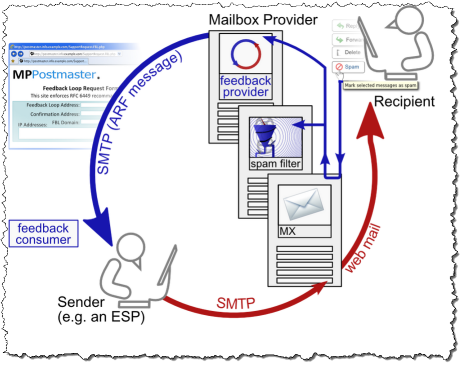AWS Messaging & Targeting Blog
Email Definitions: Feedback Loops
What goes around… Comes around! Does this proverb apply to your email-sending program? Probably not as much as you’d like. Ideally, you’d have a direct window into each interaction a recipient has with your message: Did they actually open it? If so, did they scroll through it? Did they forward, delete, print, or file it? That feedback is not available to us yet, so let’s focus on the information we do have, and how it finds its way back to us.
Currently, the only insight you have into the mailbox interactions between recipients and your email is when recipients click a “This is Spam” button in their mailbox interface. This process is known as abuse complaint. The mechanism through which complaints are directed back to you, the sender, is referred to as a feedback loop (FBL). You need to subscribe to a FBL in order to receive the feedback.
To subscribe to a FBL, you must verify that you own the sending domains and/or IP addresses. Although the process is relatively streamlined, it’s not standardized and it can get tedious due to the variety of means by which different ISPs (mailbox providers) ask you to subscribe. Luckily for you, Amazon SES handles all FBL subscriptions on your behalf. For SES customers, the process is as follows:
- The recipient clicks “This is Spam” in their mailbox interface.
- The ISP records and forwards this request in Abuse Reporting Format (ARF) to Amazon SES.
- SES then sends the notification to you via email or an Amazon Simple Notification Service (Amazon SNS) topic, depending on your account configuration.
Here is a great graphic to help you visualize a sample FBL:

© Alessandro Vesely. This is a file from the Wikimedia Commons. Information about it is available from its description page there.
Do all ISPs support feedback loops? Unfortunately, no. If you are curious, review the Word to the Wise Delivery Wiki for a relatively up-to-date list.
All right, at this point you should be able to track the recipients that complain about your email. Best email practices dictate that you shouldn’t continue messaging to those folks (or at least don’t send the same type of content). For example, although I may be unhappy with daily emails, I always expect my order confirmations and wouldn’t mind receiving a monthly newsletter. So consider what type of content your recipients object to (e.g. promotions) but keep in mind that transactional mail tends to be well-received.
The ultimate technique to avoid complaints is to focus on delivering high-quality content to your recipients. After all, they signed up for your email program for a reason — anything you can do to improve that value proposition should drive spam complaints down.
What goes around comes around, right? Comments, questions, thoughts, please take advantage of our “feedback loops” — post here on our blog, use the customer forum, or find us on Twitter. Happy emailing!